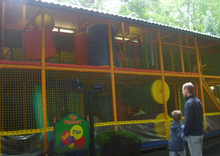

This article has multiple issues. Please help improve it or discuss these issues on the talk page. (Learn how and when to remove these template messages)
|
Afamily entertainment center (FEC) in the entertainment industry,[1] also known as an indoor amusement park, family amusement center, family fun center, soft play,[2] or simply fun center, is a small amusement park marketed towards families with small children to teenagers, often entirely indoors. They usually cater to "sub-regional markets of larger metropolitan areas."[1] FECs are generally small compared to full-scale amusement parks, with fewer attractions, a lower per-person per-hour cost to consumers than a traditional amusement park, and not usually major tourist attractions, but sustained by an area customer base. Many are locally owned and operated, although there are a number of chains and franchises in the field.[1] Some, operated by non-profit organizations as children's museumsorscience museums, tend to be geared toward edutainment experiences rather than simply amusement.
FECs are essentially a converged outgrowth of theme restaurants that increasingly developed their in-house amusement features, small-scale amusement parks needing more offerings than just a few rides and midway games, and diversifying formerly one-attraction venues (water parks, skate parks, billiard halls, bowling alleys, and so on).[3] All three categories have moved over several decades continually toward stock, popular entertainment solutions supplied by third-party vendors. Chuck E. Cheese, opened in 1977 as Chuck E. Cheese's Pizza Time Theatre in San Jose, California, was one of the earliest widely known examples of these in the United States.[1]

Most FECs have at least five common major or "anchor" attractions, to provide diverse patrons (often in large parties) at least one to two hours of entertainment, to encourage repeat visits, and to reduce time spent waiting for any given attraction.[1] Some of the more usual attractions include (depending upon size, climate, etc.):

The most common anchor activities are miniature golf, kart racing, arcade and redemption games, and food & beverages, according to industry specialists StoneCreek Partners.[1] FECs rarely use custom-built attractions, because of the costs involved, and instead install off-the-shelf systems provided and maintained by industry equipment vendors.[1]
Any given FEC may lean more towards outdoor activities, arcade gaming, or passive entertainment and dining. Each may cater to different age ranges, all the time, or during certain hours, e.g., children and entire families in the daytime, and teens to young adults in the evening, with specific promotional programs to attract different market segments at different times.[1]
FECs tend to serve "sub-regional markets",[1] such as small cities, quadrants or boroughs of larger cities, and a large suburban area outside such a city. Their busiest times are weekend afternoons and Thursday through Saturday evenings.[1]
Because most of the attractions are essentially the same from FEC to FEC,[1] two of the most important factors in a particular center distinguishing itself to potential customers are a highly visible location[1] (hard to obtain because other uses for the land are often more competitive[1]), and a consistently developed and promoted theme that appeals to the target market segments, "the fun factor in the overall decor".[1]
Parental concerns are also important. While children themselves rarely think of it, a major factor in the attractiveness of an FEC to parents is on-site safety and security, as adults may drop off older children at such an establishment to entertain themselves.[1] An increasingly important factor for success is high-quality food and drink to attract parental spending as well as whole-family dining.[1]
Various major media and entertainment brands, including Disney, Lego, NASCAR, Sega, Sony, United Artists/Regal and Viacom, have been attached to family entertainment centers, often much less "traditional" than local and chain FECs, with custom-built, unique attractions, usually heavily branded, and most often located in major metropolitan areas. The first such urban entertainment center (UEC) was the Universal CityWalkinLos Angeles, California, which opened in 1993, linking several Universal properties.[4] Including various retail outlets, restaurants, and attractions, the CityWalk created a great deal of "sustained buzz" in the retail real estate industry, which began "embracing the notion that Universal Studios, Sony, Disney, and other entertainment companies could create new anchors and entertainment programs for shopping centers".[4] Another significant UEC was the Sony MetreoninSan Francisco, California (1999–2006).[5]
Some nonprofit, educational installations, such as the Exploratorium in San Francisco, also have aspects of FECs in format and atmosphere, but with activities geared toward learning and experiencing rather than simple entertainment. Some for-profit enterprises also use this model, or mix edutainment with simpler amusement attractions.
The main national industry group in the U.S. is the National Association of Family Entertainment Centers (NAFEC), which is a division of the International Laser Tag Association (ILTA).
Some U.S.-based companies also have venues in Canada (noted above), but this is rare due to the legal/political difficulties involved in cross-border corporations.
North American FECs vary wildly in themes, size and features. Some of the larger businesses in this category have included:[1]
{{cite web}}: Missing or empty |url= (help)